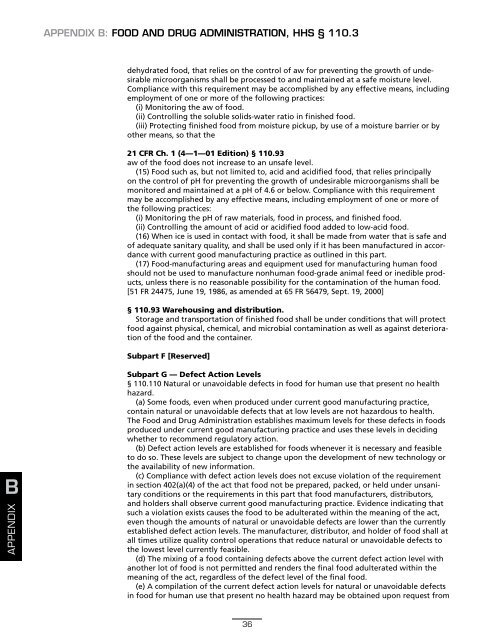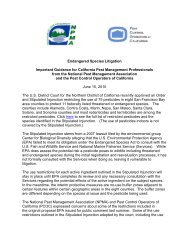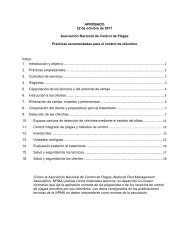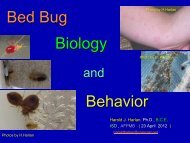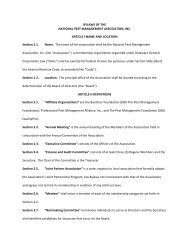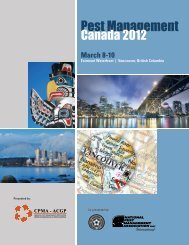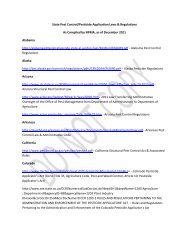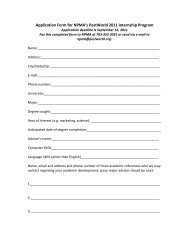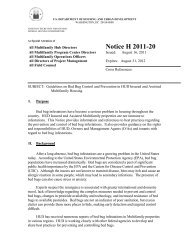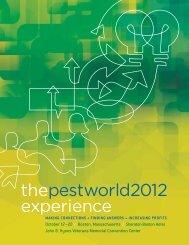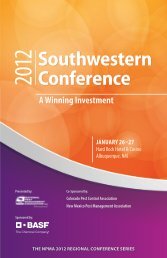Pest Management Standards For Food Plants - National Pest ...
Pest Management Standards For Food Plants - National Pest ...
Pest Management Standards For Food Plants - National Pest ...
You also want an ePaper? Increase the reach of your titles
YUMPU automatically turns print PDFs into web optimized ePapers that Google loves.
Appendix B: <strong>Food</strong> and Drug Administration, HHS § 110.3<br />
dehydrated food, that relies on the control of aw for preventing the growth of undesirable<br />
microorganisms shall be processed to and maintained at a safe moisture level.<br />
Compliance with this requirement may be accomplished by any effective means, including<br />
employment of one or more of the following practices:<br />
(i) Monitoring the aw of food.<br />
(ii) Controlling the soluble solids-water ratio in finished food.<br />
(iii) Protecting finished food from moisture pickup, by use of a moisture barrier or by<br />
other means, so that the<br />
21 CFR Ch. 1 (4—1—01 Edition) § 110.93<br />
aw of the food does not increase to an unsafe level.<br />
(15) <strong>Food</strong> such as, but not limited to, acid and acidified food, that relies principally<br />
on the control of pH for preventing the growth of undesirable microorganisms shall be<br />
monitored and maintained at a pH of 4.6 or below. Compliance with this requirement<br />
may be accomplished by any effective means, including employment of one or more of<br />
the following practices:<br />
(i) Monitoring the pH of raw materials, food in process, and finished food.<br />
(ii) Controlling the amount of acid or acidified food added to low-acid food.<br />
(16) When ice is used in contact with food, it shall be made from water that is safe and<br />
of adequate sanitary quality, and shall be used only if it has been manufactured in accordance<br />
with current good manufacturing practice as outlined in this part.<br />
(17) <strong>Food</strong>-manufacturing areas and equipment used for manufacturing human food<br />
should not be used to manufacture nonhuman food-grade animal feed or inedible products,<br />
unless there is no reasonable possibility for the contamination of the human food.<br />
[51 FR 24475, June 19, 1986, as amended at 65 FR 56479, Sept. 19, 2000]<br />
§ 110.93 Warehousing and distribution.<br />
Storage and transportation of finished food shall be under conditions that will protect<br />
food against physical, chemical, and microbial contamination as well as against deterioration<br />
of the food and the container.<br />
Subpart F [Reserved]<br />
B<br />
APPENDIX<br />
Subpart G — Defect Action Levels<br />
§ 110.110 Natural or unavoidable defects in food for human use that present no health<br />
hazard.<br />
(a) Some foods, even when produced under current good manufacturing practice,<br />
contain natural or unavoidable defects that at low levels are not hazardous to health.<br />
The <strong>Food</strong> and Drug Administration establishes maximum levels for these defects in foods<br />
produced under current good manufacturing practice and uses these levels in deciding<br />
whether to recommend regulatory action.<br />
(b) Defect action levels are established for foods whenever it is necessary and feasible<br />
to do so. These levels are subject to change upon the development of new technology or<br />
the availability of new information.<br />
(c) Compliance with defect action levels does not excuse violation of the requirement<br />
in section 402(a)(4) of the act that food not be prepared, packed, or held under unsanitary<br />
conditions or the requirements in this part that food manufacturers, distributors,<br />
and holders shall observe current good manufacturing practice. Evidence indicating that<br />
such a violation exists causes the food to be adulterated within the meaning of the act,<br />
even though the amounts of natural or unavoidable defects are lower than the currently<br />
established defect action levels. The manufacturer, distributor, and holder of food shall at<br />
all times utilize quality control operations that reduce natural or unavoidable defects to<br />
the lowest level currently feasible.<br />
(d) The mixing of a food containing defects above the current defect action level with<br />
another lot of food is not permitted and renders the final food adulterated within the<br />
meaning of the act, regardless of the defect level of the final food.<br />
(e) A compilation of the current defect action levels for natural or unavoidable defects<br />
in food for human use that present no health hazard may be obtained upon request from<br />
36


